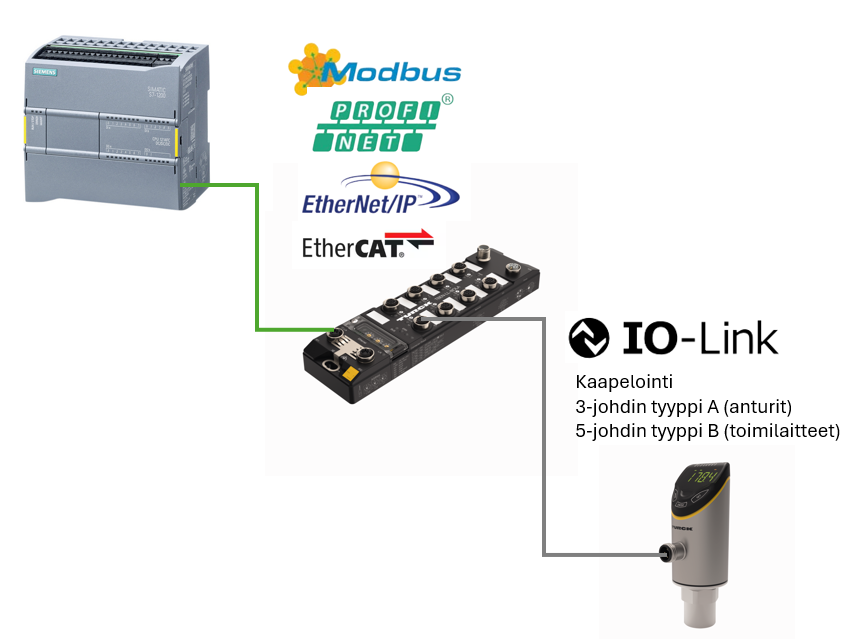Tuotehaku
Tuotemerkit
Valitse merkit
- Kaikki
- Adev
- ADZ NAGANO
- Aquametro
- Badger
- Banner
- Bauer Kompressoren
- Blackline Safety
- BOGE
- Classic Filters
- Codel
- Crane
- Delta Mobrey
- Detector
- Dias Infrared Systems
- Donaldson
- Dostmann
- Effecto
- EKS
- Elindco
- Emerson
- Escha
- Finetek
- Fitok
- Fortress
- FST GmbH
- Hanwha Techwin
- Hertz Kompressoren
- Honeywell
- Houdec
- Iconics
- Idem Safety
- IPR
- LASE
- Limatherm Sensor
- Lumasense
- Marsh Bellofram
- MB Connect Line
- MesaLabs
- Microsyst
- Mobotix
- Monitor
- Motrona
- Nexcom
- Optex
- Parker
- PST
- Red Lion
- Scaime
- SEG
- Seneca
- Senmatic
- SpotSee
- TURCK
- VPInstruments
- Watlow
- Zander Aachen
- Zimmerli Inert
Automaatio ja digitaaliset ratkaisut
- Anturit ja kaapelit
- Instrumentointi ja analysointi
- IIoT
- Kaasuhälyttimet
- Näyttö- ja merkinantolaitteet
- Ohjaus ja tiedonsiirto
- Robotiikka ja konenäkö
- Turvallisuus
Paineilma
IO-Link and Its Benefits
IO-Link


What is IO-Link?
IO-Link is a digital interface for bidirectional data communication between intelligent sensors or actuators and a control system. IO-Link is the first globally standardized (IEC61131-9) IO technology.
- All major automation product manufacturers use IO-Link technology, which ensures a wide selection.
- IO-Link is fieldbus-independent and can also transmit analog data.
- IO-Link sensors and standard sensors can be used together.
- IO-Link technology has many advantages over traditional I/O communication.
Read the latest information on the IO-Link organization's website
Advantages of IO-Link
- IO-Link sensor parameterization from a single location via the bus speeds up commissioning.
- Wiring uses the same M12 standard industrial cables as traditional I/O.
- Sensors are connected to the IO-Link Master, where parameters are stored. Replacing a faulty sensor is easy because the new sensor does not need reparameterization; parameters are automatically downloaded to the new sensor.
- Digital signal transmission eliminates D/A and A/D conversions and is also more accurate and faster than traditional analog transmission.
- Diagnostics: sensor error states and alarms can be detected remotely, speeding up troubleshooting.
- Each device can be assigned its own identifier (Application Specific Tag). When tools are changed, necessary adjustments can be made automatically.
What is needed for commissioning?
- Wiring
- Bus cabling between the automation system (e.g., Siemens) and the Master unit
- 3-wire cable between the Master unit and sensors
- Master unit
- The Master unit connects IO-Link devices and the automation system
- Monitors and controls I/O-Link devices
- Parameterization
- Parameterization either from the sensor or remotely from the control system
- Once the sensor is parameterized, a replacement does not require reparameterization
/K%C3%A4sitellyt%2006%202024/Automaatio2024%20mittaus%20valvonta%20huolto%20kaasuh%C3%A4lytin%20(38).jpg?width=480&height=360&name=Automaatio2024%20mittaus%20valvonta%20huolto%20kaasuh%C3%A4lytin%20(38).jpg)
